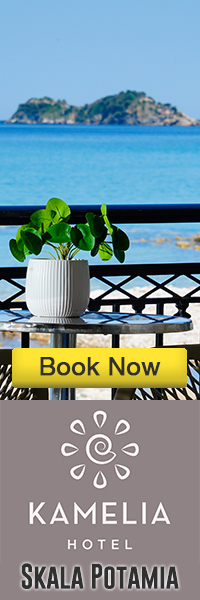Religion & Faith
The Orthodox Faith
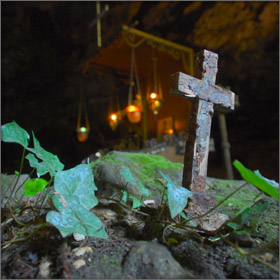
Thassians have a long history of searching for their Maker and trying to understand the mysteries of this world. Every visitor to the island can see old Christian churches built on top of the ruins of older temples, built on top of more ancient ones.
There are more than 60 little churches all over the island, a relatively large number compared to the population, a clear testament of the island's Orthodox faith.
Monks from Mount Athos, on the mainland west of Thassos, often visited the island and built miniature versions of their monasteries between 1827 and 1926 to enrich the island's religious faith.
Furthermore, many Thassians visited Mount Athos and brought customs and traditions from the monasteries back with them. They subsequently incorporated some elements of these traditions into their way of life.
Today, expression of their faithfulness consists of more than just attending Sunday Liturgy. They take part in religious services and ceremonies, including those where bones and skulls of saints are transferred from Mount Athos to Thassos for public veneration. Some individuals offer donations of time and service, while others offer money for the building of new churches, and, in some instances, entire personal fortunes have been offered to the memory of their patron saints.
The Orthodox faith is strong on the island and provides the locals with answers they need. If you're looking for spiritual renewal, a visit to Thassos may provide the peace and serenity you need.
Holidays and Feasts
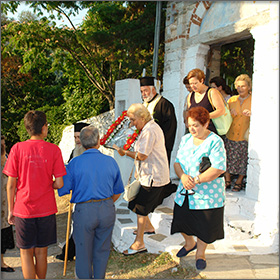
Religious festivals are great opportunities for locals and tourists to meet. These festivities, in many ways, link the residents' Orthodox faith with their social lives, playing an important role in the religious life of the Thassian people.
Holidays and feasts take place all over Thassos throughout the whole year. There are two main purposes of these organised festivities: to commemorate a celebrated saint's memory and for the people to take part in a genuine folklore festival. Through dancing and singing, people get to express their religious faith in a social manner that can be fun for everyone. These rituals are basically the same everywhere.
After the religious service, people gather to enjoy a local delicacy called kloubani or kourbani, a stew with meat and tomato sauce, cooked in big pots and usually garnished with pasta. Participants receive and eat it prayerfully, remembering the Christ-like characteristics of each saint, as they strive to integrate those qualities into their own character. They gather in groups and dine in a merry and joyful mood. If you have the chance, try to take part in such an occasion. It will be an experience you will never forget.
The Feast of the Epiphany is celebrated in the coastal villages of Thassos.
Celebration and feast in memory of Saint John in the village of Prinos.
Celebration and feast in memory of Saint George the Hozeviti in the village of Kazaviti.
Celebration and feast in memory of Saint Anthony in the village of Potos.
Celebration and feast in memory of Saint Athanasios in the village of Kastro.
Celebration and feast at the church of Dedication of the Lord in the village of Skala Kallirachi.
Celebration and feast in memory of Saint Haralabos in the villages of Skala Panagia and Kazaviti.
In 2023, Easter Sunday will be on 16 April.
Easter is the most holy and celebrated day of the Orthodox Christian calendar, and celebrations takes place all over the island. Easter is not on a set calendar date, rather it is what Greeks call a "moving holiday". The date changes every year depending on the full moon in spring time. Various festivals and events take place around the island during the whole week of Easter, making it a wonderful time to visit.
Celebration and feast in memory of the Holy Apostles, at the churches of the 12 Apostles, in the villages of Kazaviti and Limenas.
Celebration and feast in memory of Saint Marina, at the little churches of St. Marina in the villages of Kallirachi and Limenas.
Celebration and feast in memory of the Prophet Elijah in the village of Skala Sotiros.
Celebration and feast in memory of Saint Paraskevi in the villages of Skala Rachoni, Skala Panagia, and Theologos.
On the evening prior to the day of celebration, people gather at the church in Kazaviti to take the icon of Saint Panteleimon and transfer it by foot via mountain paths to the Monastery of Saint Panteleimon, located on the mountain above the village. There they spend the night and on the next day they have a celebration and feast in his memory.
Celebration and feast in recognition of The Feast of the Transfiguration of Our Lord, God and Saviour Jesus Christ, in the village of Sotiros.
Celebration and feast in memory of the Virgin Mary, in the villages of Rachoni, Potos, as well as at the Monastery of Panagouda near the village of Maries. This is the third most holy day of the Orthodox Christian calendar, after Easter and Christmas. Panagia, the village named after the Virgin Mary, is especially alive and festive, receiving thousands of visitors and holding a big street bazaar.
Celebration and feast in memory of Saint John, at the little church of St. John on the mountain above the village of Prinos.
Celebration and feast in memory of Saint Paraskevi in the village of Theologos.
Celebration and feast in memory of Saint Dimitris in the village of Theologos, at a little church in Prinos, as well as in Kalivia near Limenaria and in Limenas.
A day that is dedicated to the Archangel Michael, celebrated at the Monastery of Archangelos, as well as in the villages of Maries and Limenas.
Celebration of the Virgin Mary's entrance into Heaven in the village of Potamia.
Celebration and feast in memory of Saint Nicholas in the villages of Limenas, Kallirachi, Prinos, Rachoni, Limenaria and Potos.
Celebration and feast in memory of Saint Eleftherios in the village of Limenaria.
Easter in Thassos
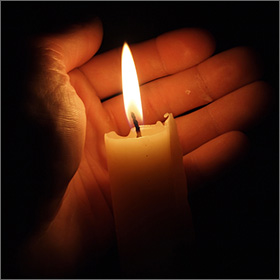
In many ways, the Easter period is a time of rebirth for Thassos. Nature wakes up from its winter slumber, bringing with it vibrant colours and sweet aromas. Housewives are cleaning their gardens and planting beautiful flowers around their homes. Street curbs and alleyways are being “white washed” to reflect cleanliness and freshness in the villages. Days are getting longer, the weather is getting warmer, and this is when locals and tourists gather together to celebrate Easter, the biggest Orthodox Christian holiday of the year.
Life returns to the island as more hotels are beginning to open, more tavernas are preparing wonderful delicacies, and more tourists are beginning to come. Despite everyone being very busy preparing their properties and businesses for the upcoming summer tourist season, Thassians never neglect celebrating this holy occasion.
On the days leading up to Easter, during Holy Week, churches fill with people every day. "Megali Evdomada" is what the locals call it.
On Great Friday (known as Good Friday to western Christians), the period of mourning reaches its climax as the death of Jesus is commemorated. Children go outside and pick up the prettiest flowers they can find, and then lay them around the symbolic tomb of Jesus.
Then on Saturday, people bring red-dyed eggs to church for the night of the Resurrection and stay up until well past midnight, when everyone goes home to end their fasting and enjoy a traditional soup called "Magiritsa".
On Easter Sunday, families and friends get together in a festive and joyful spirit to have the traditional lamb on the spit. Normally an unofficial competition takes place between the locals of every village to see who cooked the best lamb!
Several other events take place during this time of celebration, complimenting those of Easter and making it an especially wonderful and unique time to visit Thassos.
| Events | The Burning of Judas The Archangel Michael's Icon Come Our April, Let it Rain! | ||
Events During the Holy Week of Easter
The Burning of Judas
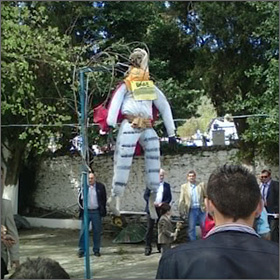
A unique folklore event takes place in the mountain village of Panagia on Easter Sunday.
The villagers make a model representing Judas, the disciple who betrayed Jesus. The model of Judas is placed on a donkey and walked through the village. Cries of disapproval follow the donkey through the narrow and windy streets until it reaches the church of the village. Upon arrival, the model is wrapped up in branches from fig trees, the kind of tree on which Judas hanged himself. As soon as the church bells ring to announce Christ's Resurrection, the model of Judas is set on fire.
A very special atmosphere follows this tradition and all who experience it.
The Archangel Michael's Icon
On the Monday after Easter, shortly after lunchtime, a great procession takes place in Theologos. The icon of the Archangel Michael is carried through the village, followed by a multitude of people. It is walked along every street and passes by every house so that everybody gets a chance to venerate the saint's icon.
The icon is then transported by foot from Theologos to the Monastery of Archangelos (the Archangel Michael). It is an incredible three-hour journey along rocky mountain paths, with continuous singing and chanting by the priests and choir.
After arriving to the monastery, a liturgy takes place. It is followed by a joyful celebration and feast proclaiming the message of Christ's Resurrection. Participants bring homemade food and treats to share with everyone during the festivities lasting the whole night. The next morning, the pilgrims begin their return home to Theologos.
The icon is cheerfully welcomed back by residents gathered at the village's entrance. The air is filled with joyful tunes coming from church bells and choir hymns. People exchange best wishes and handshakes, proclaiming "Christ has risen, indeed He has!" After greetings have concluded, a banquet is held at the monastery's "little premises" at the center of the village.
The Archangel Michael is the patron saint of Theologos. Locals have traditionally prayed to him for comfort during difficult times, and for thanksgiving during good times. This special event is held to honour him, while offering the island's visitors yet another opportunity for a unique experience during the Easter period.
Come Our April, Let it Rain!
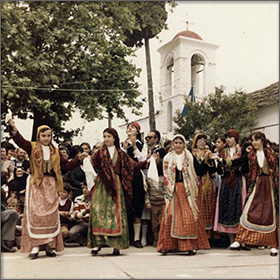
On the Tuesday after Easter, tourists are welcome to take part in a local traditional event in Kalivia, a small settlement near Limenaria.
As soon as the morning liturgy ends, everyone, both young and old, comes together to participate in an open air service that includes a procession with the icons from the local church through the entire village. At the end of the procession, they circle around a very old plane tree located at the central square where they hold hands and perform a traditional dance.
The joining of young and old for this dance symbolises fertility and life. A woman, the dominant symbol of fertility, is chosen to be the leader of the dance. Everyone raises their hands towards the heavens and slowly step inward to each other, chanting: "Here comes May and Spring, and soon will follow Summer! Come on April, let it rain! Make it nice for a stroll in May! Now's the time when Christ has risen, now's the time He has truly risen!"
This dance dates all the way back to ancient times when people spoke about the eternal circle of life. It symbolises the wearing out and rebirth of Earth through the power of water, the essential element for a seed to grow, and for life itself to exist.
The dance has a deep spiritual meaning as it consists of a hymn to both God and Mother Nature, during the month which typically brings the most rainfall. The chant is a customary call for rain and fertility which will provide all that is needed for survival. Water that comes down from the sky, they believe, is a giver of life to all humanity and all living creatures on Earth.
The event is followed by a delicious banquet prepared by the deacons of the church, with plenty of local tsipouro and other delicacies.
It's an original and authentic local event that is a fun experience for everyone. Don't miss it!
Monasteries & Churches
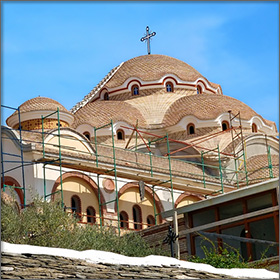
Thassos has 3 monasteries and over 60 churches, big and small. Every village has at least one church that is used for Sunday Liturgy. The rest of the island's many churches are small and scattered on hillsides and mountain tops, in forests and olive groves, and along the coast. They are all places where you can go to say a prayer, light a candle, and find infinite peace in the midst of God's beautiful creations of nature.
There are far too many for you to visit during one short holiday, but there are a few that are really worth seeing.
| Monasteries | Archangelos Saint Panteleimon Panagouda | ||
| Churches | Virgin Mary in Panagia Virgin Mary in Rachoni | ||
Monasteries
Archangelos

The monastery of the Archangel Michael sits in a picturesque setting at the top of a rocky cliff between the villages of Astris and Alyki. It is a breathtaking sight with its massive, rugged rocks forming the foundations of the monastery hundreds of metres above sea level, the sea beneath it stretching endlessly into the blue horizon, and its spectacular view of the holy Mount Athos gracefully rising high out of the Aegean.
This is one of the few remaining monasteries that was established by monks from Mount Athos. October of 1974 saw the arrival of the first seven nuns, turning the monastery into a convent. It remains a dependency of Philotheou Monastery of Mount Athos to this day.
There are several legends that speak of the monastery's creation. One of the most told legends is that of an underground spring where holy water flows deep beneath the monastery's rock base inside a cave, which is the reason this site was chosen.
The Miraculous Holy Water
In 1090 AD, a monk called Saint Luke came to this area to find his inner peace and ended up in the village of Theologos. He built a little church to honor Saint John the Theologian, after whom the village was named. Soon thereafter, the village became crowded with people so the monk, wanting to find peace again, fled from Theologos to the area of “Deep Potamia”, where the Monastery of Archangelos stands today.
According to legend, the Archangel himself appeared to Saint Luke and told him that he was going to die in three years. As a sign of his presence to the monk, the Archangel is said to have hit a rock with his staff, where holy water with incredible healing powers began pouring out. He then ordered the monk to build a little church in his honour. Great multitudes of people later flocked to this place for healing and worship.
During the years that followed, the Ottoman Turks occupied Constantinople (known today as Istanbul) and then invaded and occupied the island of Thassos. Despite the intimidation of the Ottoman Empire's rule, Orthodox Christians would still visit the church of the Archangel Michael in large numbers.
Rumours started to spread about a lot of people being healed by the holy water coming from the spring. This disturbed the Ottomans greatly, who, in turn, ordered for the pollution of the spring. It is said that water stopped pouring out from the spring as soon as the Ottoman unbeliever began performing an abominable act. In an interesting twist, he then got struck by lightning and died instantly in front of the spring.
The next day, the Archangel appeared to the priest of the parish, Father Dimitris, and to his followers. They first were ordered to remove the body of the unbeliever from the spring. He then revealed to them a new spring where holy water would pour out, located inside a cave far beneath the monastery. Everyone present went exactly to where the Archangel instructed and entered the cave kneeling, and for that reason the place has always been called “Knees”.
Legend has it that whoever goes down the cave and drinks from the miraculous water will be healed.
The Honourable Nail
The extraordinary presence of the Archangel Michael is closely associated with the story of the Honorable Nail.
Is is said that Nikiforos Votaniatis, Emperor of the Byzantine Empire (1078 – 1081 AD), dedicated the right hand nail of Christ's crucifixion, along with other holy relics, to the monastery of Philotheou in Mount Athos, where it was kept for hundreds of years.
After the fall of Constantinople in 1453 AD, the monasteries of Mount Athos found themselves short of funds and needed to find a way to replenish their coffers. Thus they started carrying their collection of holy relics to Orthodox communities in the region, offering open worship service in return for donations.
A number of monks went aboard a ship and set off for Constantinople, carrying relics with them. The ship was overtaken by high winds and turbulent waters and was subsequently forced to land on the island of Thassos. While there, the monks got attacked, pillaged, tortured and slaughtered by pirates. However, prior to this action, the monks managed to hide all the relics in a secret wall of the Archangel's monastery.
Later, a local believer had a vision of the Archangel Michael, who told him to go down to the “Knees” cave in order to worship and be healed. Obeying the Archangel's wishes, he went to the cave and discovered by accident all the holy relics that were left by the monks from Mount Athos. The locals then handed all of them over to the representative of the Monastery of Philotheou. However, the Honorable Nail was forgotten on top of a wild olive tree and was not handed over with the other relics.
After some time, a local shepherd and his son would continually dream of a bright light on top of the wild olive tree where the nail was forgotten. They went to the tree and discovered the holy relic at the same spot as the bright light appeared in their dreams. Not knowing what else to do, they handed it over to the priest of Theologos, Father Theonas, who immediately sent it to the monastery of Philotheou in Mount Athos.
It is said that the Archangel himself rebuked the priest for this act and moved the Nail back to his monastery on Thassos. It is kept in an icon created by a Bulgarian priest, Father Anastasios, built in gratitude of the Archangel for healing a long term disease that he had.
Ιn remembrance of the Archangel's divine transportation of the relic to the monastery, the residents of Theologos perform a special ceremony every year. On Easter Monday, they transport the icon of the Archangel from the monastery to their village, and on Easter Tuesday it is returned back to its place in the same procession.
Miracles of Archangel Michael
The monastery is a source of comfort and revival for thousands of visitors every year, many of whom suffer from painful diseases and seek the Archangel's prayers and healing. Miracles reported to have taken place here has made the monastery a well-known religious and holy place throughout all of Greece.
"I come from the village of Potamia and I now reside in Kato Patisia in Athens. I came to the Archangel as a pilgrim as I was desperate. I had been married for 2 years but couldn't bear a child. There was no hope coming from the doctors. A nun here at the monastery gave me comfort and counseling. She told me that if I have faith in the Archangel he will help me. After a few months of struggling with doubt I decided to trust in the power of God and then after a few months I had my first child. Not only that but I've had two more children after my first. As a result of my getting closer to God my whole life got completely transformed."
Ms Maria Halanouli-Tertipi from Athens, Greece
"On the 17th May in 1992, our little girl Athanasia fell off a roof which was 4 metres high. She was immediately transported to the central hospital of Thessaloniki in a state of comma. During transport, the child was firmly holding the icon of the Archangel Michael which was on a brooch on her clothes. The doctors claimed that there was no hope for the child's survival. All of a sudden, the child started to come to her senses and was persistently asking for the icon of the angel that had been removed from her by the doctors. She could literally feel the presence of the archangel in the room and she started saying to us, 'Do not close the door. Let the Archangel stay here, I want him by my side.' The child could see him while we could not. Our daughter has been miraculously healed and survived an almost certain death. Now she is perfectly well and we came to give the Archangel thanks for this great gift of life and healing."
Ms Maria Ignatiadou from Thessaloniki, Greece
Saint Panteleimon
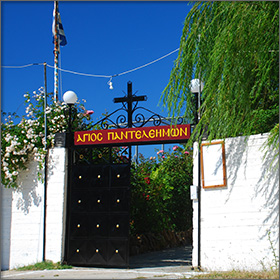
Saint Panteleimon's Monastery on Thassos began as a simple church in 1843.
Legend has it that a wealthy landowner of the island wanted to build the church in honor of Saint Panteleimon, a patron saint believed to have extraordinary healing powers. The wealthy Thassian began construction of the church at a site about three kilometres away from where it stands today. His builders would return to the construction site every day only to find everything they had built on the previous day destroyed and their tools missing. After several times of this happening, the builders finally noticed fresh footprints leaving the construction site. They followed the footprints which led them to a surprising discovery: all of their missing tools were gathered in one place. It was believed that the saint chose this location for his new church and moved the tools there for this reason. After this miraculous event, the wealthy Thassian decided to abandon the location that he himself had chosen and to commence building where the tools had been discovered. From that day onwards, the structure and their tools were never bothered again.
A unique part of the monastery is a cave located near the south wall. It houses a natural spring believed to be a source of holy water with miraculous healing properties. The temperature inside the cave consistently remains very cool during even the hottest of summer days and visitors often bring small bottles with them to fill and take home. You can easily find the cave by following a short stone path next to the church.
People come to the monastery to receive the Saint’s blessing, many of whom need healing. Those that seek healing go into the cave to leave some of their garments (or those of their loved one in need of healing) as an offering and also drink holy water from the natural spring.
The monastery of Saint Panteleimon is located high on a mountain with one of the most breath-taking views of the island. Its magnificent panoramic view includes the lush valley below, the village of Prinos, the city of Kavala on the mainland, and on clear days, the holy mountain of Agio Oros (Mount Athos) in the far distance.
To get there you only need to drive through Prinos and to the village of Mikro Kazaviti, where the road to the monastery begins. The mountain road to the monastery has recently been asphalted and is a 15 minute scenic drive.
In 1987, the monastery was transformed into a convent, where Sister Elizabeth, the first nun to reside at the monastery, claimed that Saint Panteleimon appeared to her in a vision and asked for five more quarters to be built so that visiting pilgrims may be provided with a place to stay. The monastery was later expanded according to his wishes, and apparently for good reason. Visitors have been increasing in numbers ever since.
The memory of Saint Panteleimon is celebrated on the 27th of July. It is a special day for the island's residents and also for the visitors of the island. The tradition begins on the evening of the 26th of July. People gather at the church in Mikro Kazaviti and begin their pilgrimage on foot to the monastery. They carry with them Saint Panteleimon's icon, walking along narrow mountain paths and roads. After some hours of walking up the mountain, people begin to arrive at the monastery and commence preparations for the following day's celebration. They stay and sleep overnight and don't return home from the monastery until the celebrations are over. The participation level is high due to a great number of witnesses and a series of miracles attributed to Saint Panteleimon.
Miracles of Saint Panteleimon
A certain lady wrote in a letter to father Georgios, the prior of the monastery, that doctors in Greece had diagnosed her with a large tumor in her leg and had given her minimum hope of surviving. She went to England where she underwent an unsuccessful operation to remove the tumor. After her return she felt weak and suffered from horrible pains. In her desperation she went up to the monastery where, that same night, she was visited by the Saint who told her that she would not be in pain again.
Being very shaken she turned to her husband and asked him if he had seen anyone in the room. He answered her that he hadn’t. Then she really believed that with the intervention of the saint she would become well, which she did. Every time she would go up to the monastery, she noticed more and more improvement in her health. Today she is completely well and does not need any help with walking. She praises the memory of the Saint and thanks Him for his divine Grace to her.
A pilgrim from the neighbouring village of Sotiras mentions that with the help of the Saint he was healed of uncontrollable bleeding that was threatening his life, after drinking from the miraculous holy water which can be found in the cave next to the church.
Also many other accounts mention that, during the liturgy in his honour, the Saint made his presence tangible by moving the hanging oil lamps at the entrance of the church as well as by many other signs. The testimonies of these believers encourage them to gather on June 27 in this picturesque location, to pray and honour the memory of the Saint in a unique folk festival.
Panagouda
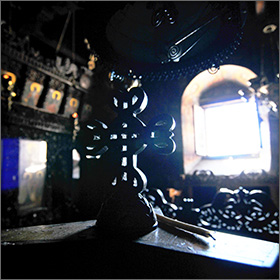
The visitor who would like to find himself at this wonderful and unique Monastery, built in a landscape among wild olive- and pine trees, only has to take a small detour to the right at the bridge, 14 kilometers from the village of Prinos in the direction of Limenaria. There, an asphalted and uphill road leads him after 11 kilometers to the small, picturesque mountain village of Maries. Four kilometers before entering the village and following a small cemented road to the left (there is of course a road sign) he will find the Monastery of the Assumption of the Virgin, sitting at the top of a small hill.
The simple and unadorned entrance prepares the visitor for what he will find on the inside. Low, stone-built walls, shadowy climbing vine, white-washed courtyards overgrown with every kind of flower, a small humble fountain; everything leads to the central church that dominates, not because it is impressive or brilliantly constructed but for exactly the opposite reason. It dominates because of its air of simplicity and modesty. The visitor can only feel devoutness and rejoicing when entering the church. There is little light in the church, only coming from the candles and oil lamps, lit by the believers. The shapes of the holy icons are impressive and the silence is only disturbed by the quiet trickle of the fountain of holy water in the church.
At the exit of the main church dedicated to the Assumption of the Most Holy Virgin, on the left hand side, one can find the recently built guest quarters, as well as the library where the visitor can have a rest. There are also the little chapel of Holy Prodromos, a real work of art, and the cells of the monks plus some other outbuildings.
We do not have written accounts of the construction of the church in its present location from before 1813. However, after research it seems all the more likely that the church was built on the ruins of a small, original church. Legend and tradition though, places the original location of the church in the area called ‘Achladi’ (pear), which is much lower than the present one.
There the people used to celebrate and honour the memory of the Virgin Mary. On the evening before one of such festivals a baby suddenly started talking and predicted the slaughter and death of residents by pirates. Panic and fear prevailed. Those who did not leave immediately were fiercely attacked and slaughtered by brutal pirates. In the general confusion, the icon of the Virgin was lost in an inexplicable way.
Legend has it that later the Virgin Mary herself, wearing black clothes and a halo, appeared to a young local shepherd and told him to build a church at the location where the lost, miraculous icon would be found again. And truly, in a nearby bush, surrounded by beautiful aroma, the icon was found. At the same place there was a well with miraculous holy water. So the people initially built a small chapel there in which they placed the icon of the Virgin, next to the fountain of holy water.
This chapel remained the only building there for many years. In 1813 it was restored and many years later, in 1947 it was changed into a church and gradually into a monastery which only recently was completed.
Miracles of the Virgin Mary
Of all the icons on the wooden iconostasis in the church, the historical and miraculous icon of the Virgin Mary, made of mastic wax, stands out. It is this icon that gave the monastery its name and which remains its unique and priceless treasure.
People from all over the country arrive here to worship the icon of Holy Mary and to give their personal accounts of the miracles of the Virgin.
As an example we will mention some of these accounts, starting with the story of the anonymous painter of holy icons of the church. Tradition says that this painter was seriously ill and while he was praying to the Virgin he promised to paint the church in case he would get healed. Out of his great humility and respect for the Virgin Mary, when he got better, he indeed painted the whole church and never wrote his name anywhere. Instead, he described the reasons that led him to this act of gratefulness on a special frame, just above the entrance on the south wall.
Another story mentions that a man broke into the church to steal all the valuable offerings that were hanging on the icon of the Virgin Mary. Even though this was easy, when he was ready to leave, he couldn’t. Holy Mary intervened and he could not find the door. It was right in front of him but he could not see it. An old lady appeared in front of him and urged him to immediately return the offerings and worship the icon, asking for forgiveness. He did just that and honestly repenting, he found the way out and left the church, praising her Grace.
Mrs. Amversa Marinou from Maries mentions that she was healed of chronic leucoma. Her illness had troubled her for four years and was not getting any better, even after trying every available therapy. Doctors had made her lose hope completely. But by faith and after worshipping the icon of the Virgin, she was healed. And then there is the account of Mrs.Sgouridou Evmorfias of Limenaria who had a nervous breakdown when she was 14. Her mother took her to the monastery of the Virgin Mary where she prayed fervently by her side. And truly, the Virgin did her miracle and the girl was completely healed.
Many more miracles have happened here. What will truly enthuse the visitor though, is simply finding himself in this holy place. After all, religious faith is experiential and the Monastery of The Assumption of the Virgin in the village of Maries offers this unique experience.
Churches
Virgin Mary in Panagia

In the mountain village of Panagia we find the church of the Holy Virgin (Panagia) that gave it its name. Daily life in this village is closely related to the religious life of its inhabitants. The name of this settlement and the fact that in the area around it there are at least 10 smaller chapels calls for more information for the visitor who wants to have a sightseeing tour or small pilgrimage.
The following chapels truly stand out: the chapel of Saint Athanasios built in 1818, the chapel of Saint Constantine and Elena, the chapel of Saint Charalampos built in 1820, the chapel of Saint John of Theologos built in 1825, the chapel of Saint Panteleimonas, the chapel of Saint George built in 1830, the chapel of Saint John built in 1835 and the chapel of Holy Mary built in 1845.
The church of the Assumption of the Virgin in the center of the village represents a big chapter in the religious history of this place. Unfortunately, the exact date of its construction cannot be found in historical sources. If we take into account that the village received its name from this church, we can deduct that the construction took place before 1821, the year the Greek revolution started.
According to tradition, the church was dedicated by the metropolitan bishop Anthimos.
In the 18th century, the residents of the ancient city of Thassos (Limenas) were forced to move inland because of raids by pirates and so they settled in Panagia. More people arrived in Panagia in 1770 when the Russian fleet appeared. This is how the population of the village increased considerably and the need for a bigger church was created.
Work began in 1831 under the supervision of builders from Kastoria who had an excellent knowledge of church architecture. The money for the start of this work was given by the notables Sotirios Avgoustis, Avgerinos and Chatzis Constantinos, whose names are written on a marble plaque in the church yard. This money though was not sufficient for the completion of such an imposing church and so it was that help was requested from the Holy Mountain. The monastery of Vatopedio was the wealthiest and offered their help.
In 1881 the new wood-carved iconostasis was finished by craftsmen from Volos. The workers from Kastoria gave the church many Byzantine characteristics of the area of Kastoria. The dome is elevated and octagonal. The steps of the Holy Sanctuary form a half circle with rays. Its length is 27,50 meters, it is 18,60 meters wide and its height reaches 18 meters.
The walls are built with marble slabs from the area of Panagia. It is noteworthy that some marble stones come from ancient ruins of churches of Thassos. The church is built in royal style with a dome, having three internal aisles and half cylindrical cupolas. Left and right of the narthex there are two small spaces called ‘grigitika’, places for the elderly ladies of the village. One of these is dedicated to Saint Charalampos.
The church has got five entrances, one big central entrance from the west and four others that lead to the side aisles. In a prominent place inside the church one can find the icon of the Virgin Mary, dated 1814 and with the title Pantavlepousa, meaning ‘All-Seeing’. Throughout Greece, the Virgin Mary is known by several different titles that honour her. The particular name used in this church is unique and can not be found anywhere else in the country.
On the fifteenth of August, starting from the evening before, there is a great celebration of worship. Thousands of guests stream in from all over the country and also the locals take part in the festivities dedicated to the memory of the Virgin. After the ‘kourbani’ or ‘kloubani’ (a special dish of red meat) is blessed and sanctified by the local priests, it is distributed to the believers. What follows are celebrations and dances in the restaurants in the area. The fifteen day long fast is ended and all locals and guests get to try the traditional goat on the spit, a special local dish. The traditional element of the greek spirit is very present, always combining deep religiosity with joy and celebration. For the visitor it is worth taking part in this festive atmosphere. To live through this unique experience will be unforgettable.
Virgin Mary in Rachoni
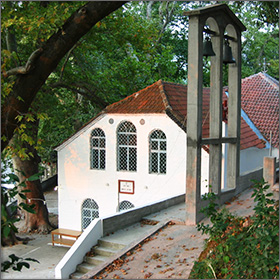
After following an upward road through forest area with chestnut and mulberry trees, coming to the mountain village of Rachoni, we find the church of the Virgin Mary located at the entrance of the village. This white, stone-built church appears near a small stream and is surrounded by cool springs. It is a remnant of the property of monasteries from the Holy Mountain on the island of Thassos. It is a monastery dependency of the monastery of Vatopedio in the village with the initial name Voulgarou.
One can not find the exact date of its construction in sources that have been saved but it is placed at the beginning of the nineteenth century. Legend mentions that a blind girl drank water from the well that sprang up in this place and washed her face with the holy water. She was immediately healed of her disease and to show her gratitude to the Virgin Mary, she built the church below the altar where even today the holy water still runs.
Every year on the fifteenth of August, there is a great celebration in remembrance of the Assumption of the Virgin Mary. All locals take part in it and it lasts three days. Outside the church that is flooded with pilgrims, big pots with ‘kourbani’ (a red meat dish) have been cooking since the evening before. Together with some kind of pasta, the meat is offered to the believers as an offering and a sign of mercy and participation in the godly pardon. Most local residents participate, offering the meat and helping with the preparations of the food. They believe that in doing so they serve the Virgin Mary and can expect her assistance. After the liturgy the celebrations start, with traditional dances by local dance companies and with the participation of the people.
Adding to the festive atmosphere are numbers of merchants that surround the church, selling their merchandise. Many locals also find their chance to promote the traditional products of their village, such as walnuts in syrup, honey and their delicious Thassian olives. This atmosphere should not put off the visitor. The festivals on the island are still authentic, having a beauty and innocence that has not been influenced by consumerism and the commercialization of modern day societies. The locals would call all of this ‘normal activities’ within the scope of the celebration of the Assumption of the Virgin Mary whom they love and respect, considering her their comfort in facing every difficulty. Visit Rachoni on the fifteenth of August to get a special taste of this unique atmosphere and, why not, participate in it yourself and live an unforgettable experience!



